A beautiful thing about the world we live in is that there’s no shortage of variety when it comes to how we experience our surroundings. From the different shapes, colors, sounds, smells (and much more), the way we experience our lives is limited only by our imagination!
Because of this wide range of sensory variety, our brain has evolved over many millennia in order for us to comprehend and perceive the world around us! Though we do it unconsciously, it’s always interesting to understand the complex mechanisms that underlie our ability to sense and process all our sensory experiences.
This chapter overview will help you to become familiar with basic topics on sensation and perception, from the biological basis of sensation to some common motifs seen in various sensory stimuli. Let’s get started!
Sensation and Perception on the MCAT: What You Need to Know
Topics on sensation and perception will be tested on the Psych/Soc section of the MCAT and can appear both as passage based and fundamental discrete questions.
Luckily, sensation and perception may not come up as often in the Psych/Soc section — expect around 3-5 questions on sensation and perception that can come up!
Introductory psychology accounts for 65% of the content covered in the Psychological, Social, and Biological Foundations of Behavior while introductory sociology covers about 30 of the content.
Important Sub-Topics: Sensation and Perception
The processes of sensation and perception have an underlying biological basis behind them as we’ll discuss below. As such, we encourage you to look back at some of the basics of neuron cell signaling and major brain function.
Better yet, try also to study these topics within the same or short time frame as by doing this, you can maximize the content overlap between these similar topics!
1. Fundamentals of Sensation and Perception
Let’s first start off by differentiating between the 2 terms sensation and perception. Sensation refers to the actual biological process where a sensory stimulus binds to a sensory receptor located in a cell.
After this, a process called transduction occurs where the information from the sensory stimuli is sent/relayed to the appropriate part of the brain to be perceived. Finally, perception is the actual process by which the brain analyzes the stimuli and eventually associates meaning with them — look at the figure below!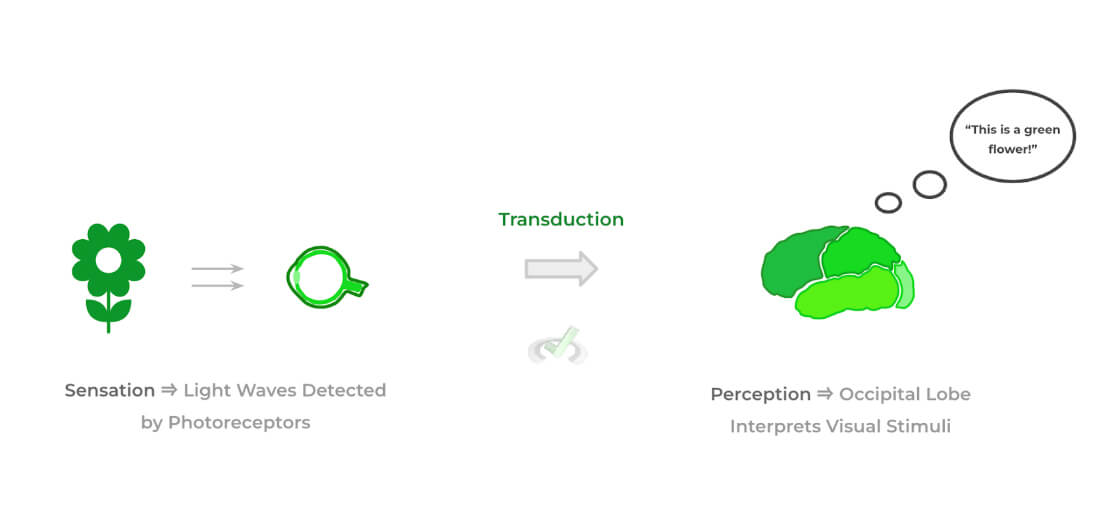
Throughout the body, there are a wide variety of sensory receptors which aid in detecting sensory stimuli from all 5 senses: taste, touch, smell, sight, and sound. Take a look below at some of the common sensory receptors and what they detect:
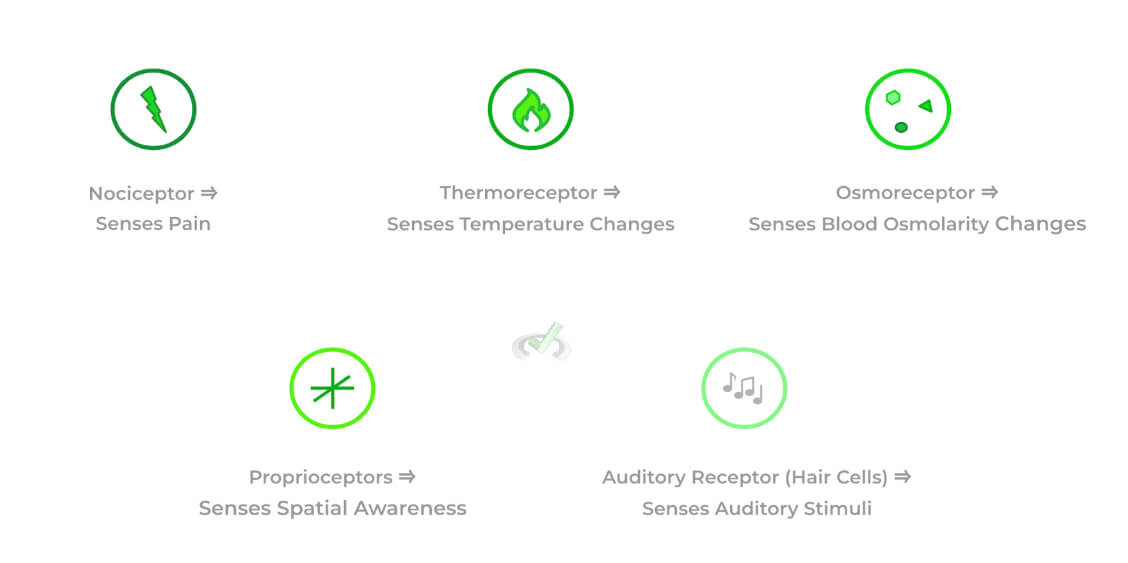
Full Study Notes : Fundamentals of Sensation and Perception on the MCAT
For more in-depth content review on wide variety of receptors used to detect the stimuli of the 5 main senses, check out these detailed lesson notes created by top MCAT scorers.
2. Visual Signal Transduction
The 2 types of sensory stimuli transduction that the MCAT will primarily test are visual and auditory signal transduction. Both are very complex when it comes to the minute details — as such, the scope for chapter overview, will restrict the content to just a superficial understanding.
Before getting into the specific cells and actual transduction pathway, it's important to get a preliminary overview of the anatomy of the eye. Outlined below are some of its major components, including the pupil, sclera, lens, retina, etc.
For this chapter overview, we’ll mainly focus on the retina. As mentioned above, the retina is important as it contains the photoreceptors which detect light stimuli, (specifically, the photons), and are the starting point for visual stimuli transduction!
Within the retina, there are 2 main types of photoreceptors that are distributed and responsible for detecting light: cones and rods. The 2 photoreceptors are responsible for detecting different types of light stimuli.
Cones are responsible for our color vision as they can detect a broad spectrum of light waves. Conversely, rods are responsible for detecting light in very dim lighting scenarios and are responsible for our achromatic vision (i.e. black and white).
When looking at the distribution of rods and cones in the retina, you’ll observe that there’s one region highly dense of cone cells (also with very few rods)— this is called the fovea. The reverse occurs when you move towards the periphery of the fovea, as the rod to cone cell ratio begins to increase!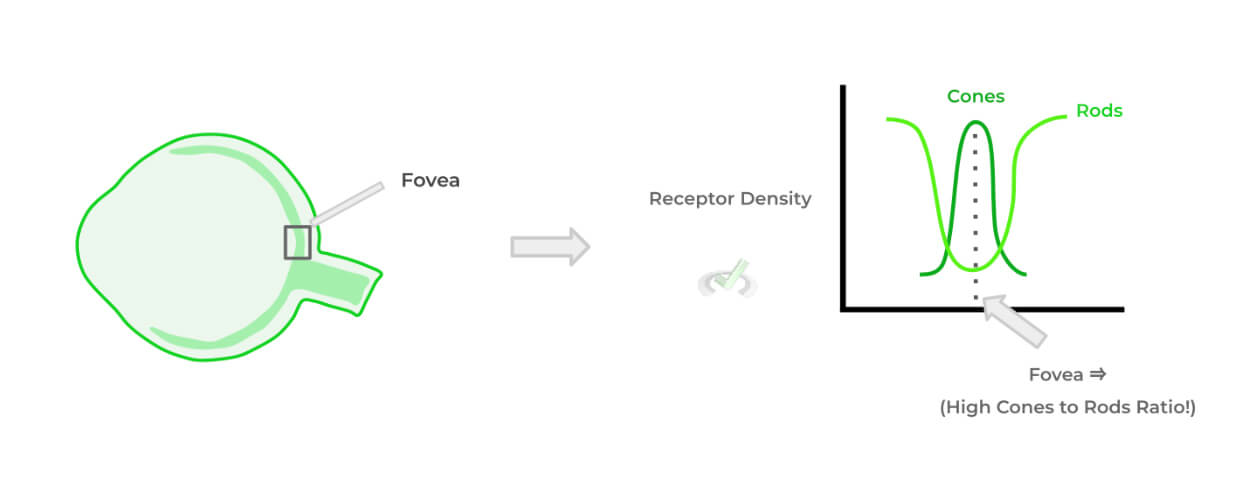
When light stimuli reach and stimulate the photoreceptors of the retina, the signals are eventually transported to the optic nerve which then travels further into the brain in order to be processed by the brain, specifically the visual cortex in the occipital lobe.
For this to occur, the signal transduction doesn’t go straight directly from the photoreceptors to the optic nerve; instead, there are various “interneurons” which are involved in the transduction of the initial light signal received by the photoreceptors.
Though an oversimplification, the signal transduction begins at the photoreceptors via the recognition of light stimuli. Afterwards, this signal is further transmitted to bipolar cells which then transmit the signal to ganglion cells. Finally, the axons of the ganglion cells begin to converge and bundle together, resulting in the optic nerve.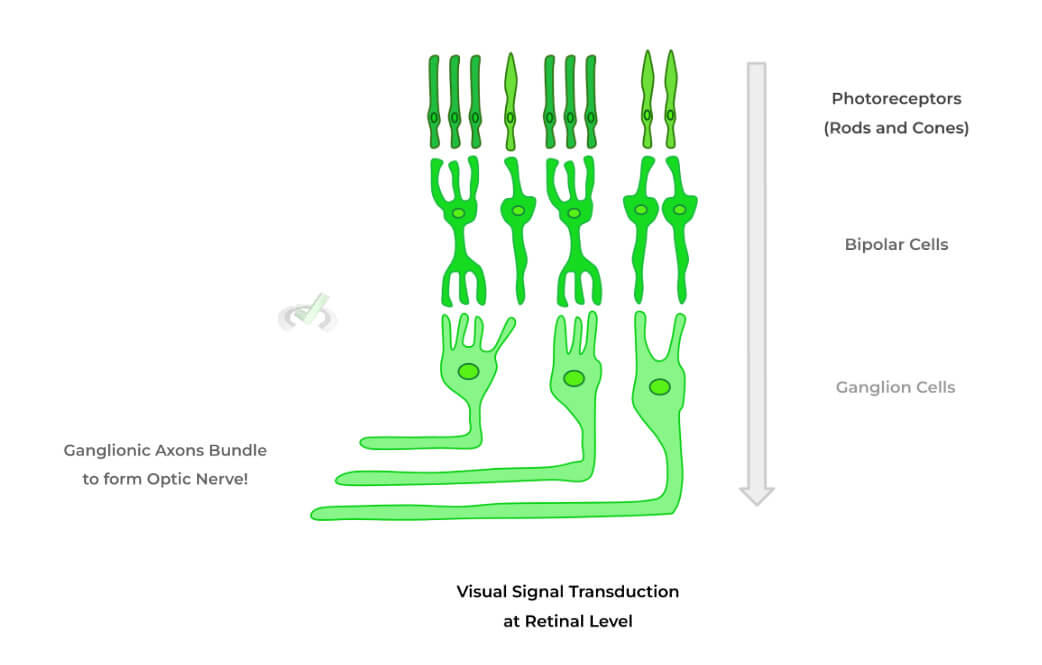
Full Study Notes : Visual Signal Transduction on the MCAT
For more in-depth content review on the signals relayed in the optic nerve enter into the brain and have a few more stops before eventually arriving at the visual cortex within the occipital lobe, check out these detailed lesson notes created by top MCAT scorers.
3. Auditory Signal Transduction
As we mentioned above, the other type of signal transduction that the MCAT will most likely test is auditory signal transduction. We’ll cover this topic the same way we covered visual transduction: a basic overview of ear anatomy followed by how the signal is eventually relayed to the brain at a cellular level.
The ear can be divided into 3 main compartments: the outer, middle, and inner ear. Check out some of the main structures of the ear, as we’ve listed below, such as the tympanic membrane, ossicles, cochlea, etc.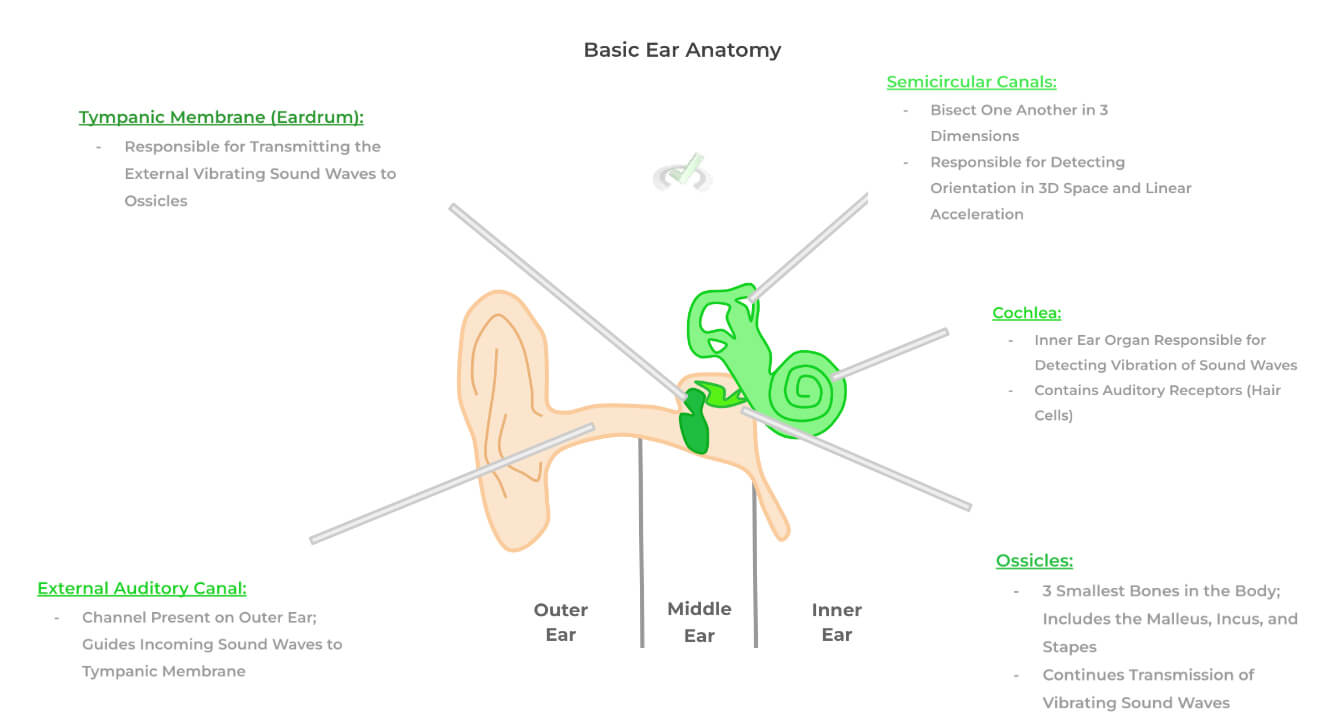
For this chapter overview, we’ll primarily focus on the cochlea as this is the main organ responsible for the transduction of sound waves as it contains special auditory receptors called hair cells.
In order to understand how the cochlea allows for auditory signal transduction, we first have to “unroll” it as you can see in the figure above the cochlea is kinda rolled up similar to a snail shell! Within the cochlea are 3 important structures: the basilar membrane, the organ of Corti, and the tectorial membrane.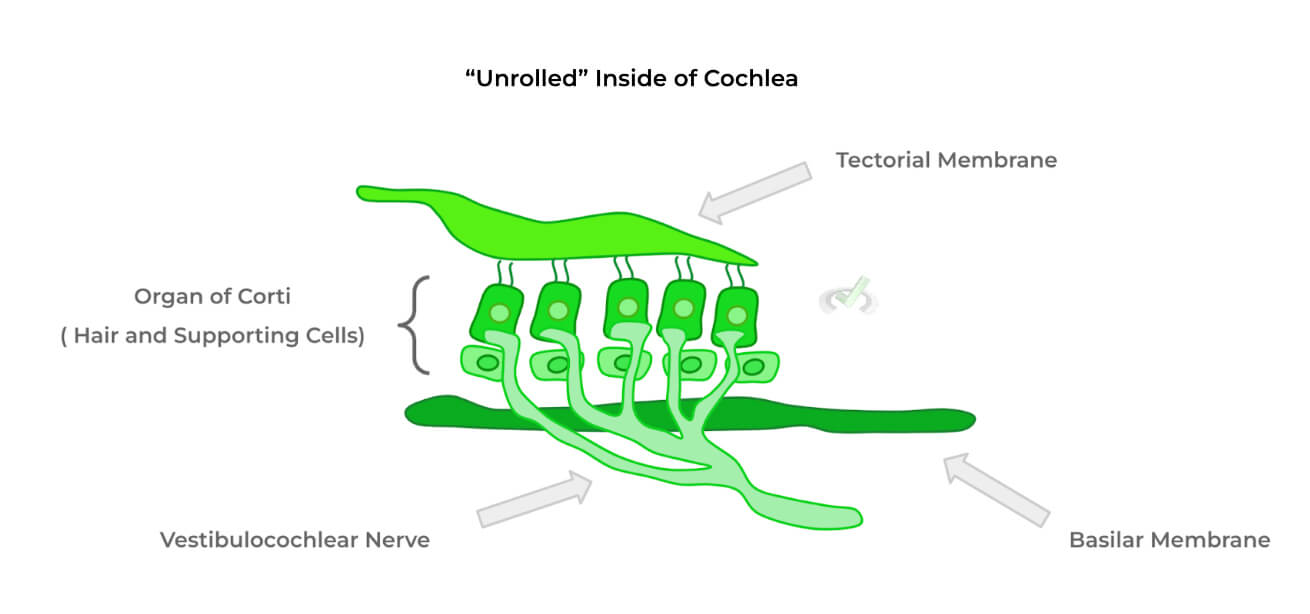
Notice how the hair cells have cilia extending from the cell body (hence the name “hair cells”) and attach to the stationary tectorial membrane. Simply put, when sound wave vibrations are transmitted into the cochlea, they transmit those sound waves to a fluid underlying the basilar membrane called the perilymph.
When fluid vibrations of the perilymph cause the basilar membrane to flex it causes the cilia to bend as well. The stretch of the cilia triggers the hair cell to send an action potential toward the vestibulocochlear nerve relaying the auditory stimuli.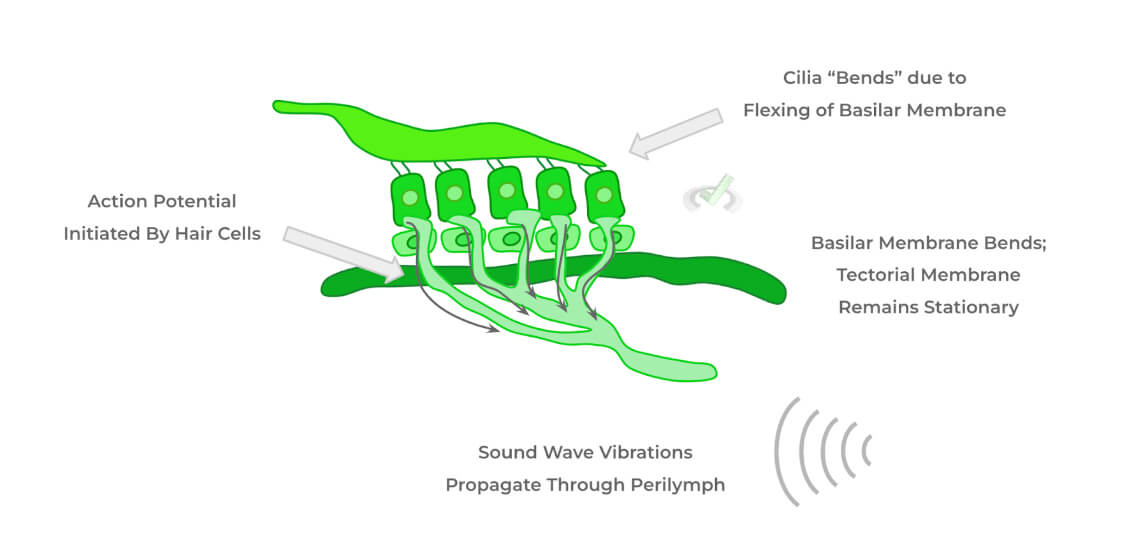
Because the hair cells require the binding of their cilia to initiate the action potential, they’re an example of a mechanoreceptor. From here, the vestibulocochlear nerve carries the stimuli toward the auditory cortex — located in the temporal lobe — in order to be further processed.
Full Study Notes : Auditory Signal Transduction on the MCAT
For more in-depth content review on the signal transduction for auditory stimuli, check out these detailed lesson notes created by top MCAT scorers.
4. Other Types of Sensory Signal Transduction
While visual and auditory sensory signal transduction are probably the most likely to be tested on the MCAT, there are other types of sensory signal transduction that should be known to a more superficial degree such as vestibular, gustatory (taste), and olfactory sense.
The vestibular sense is important as it detects stimuli about our orientation in 3D space as well as our linear acceleration: in short, the vestibular sense is responsible for our sense of balance. The main organs that aid in our vestibular sense are the semicircular canals and the otolith organs, as displayed below.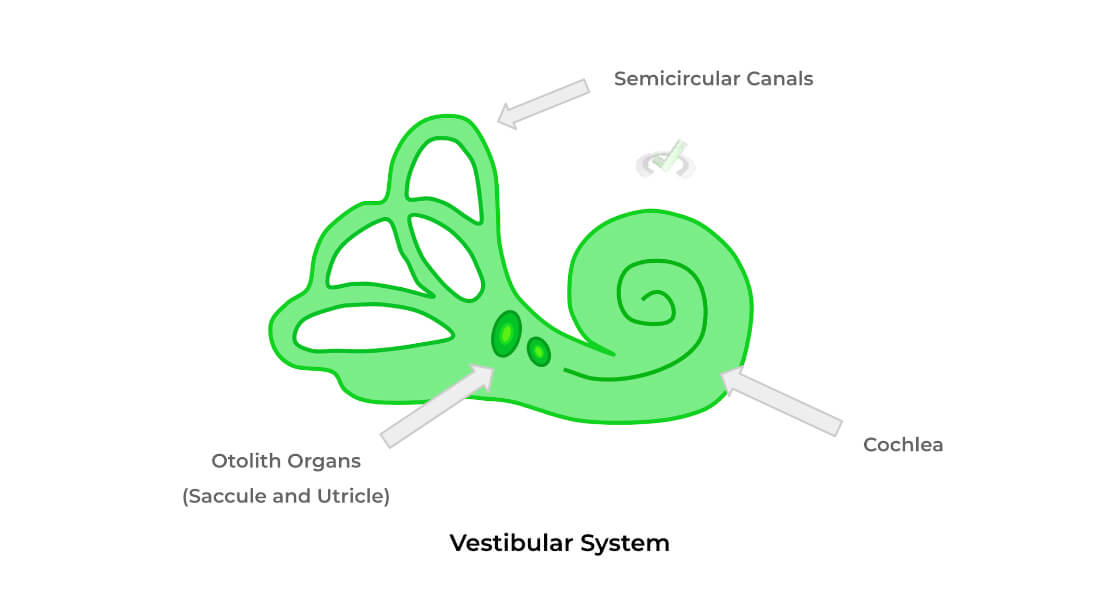
Notice also the cochlea labeled — though technically not part of the vestibular system, we included it to highlight that the vestibular organs are continuous with the cochlea in the inner ear.
However, the vestibular system has a similar way of detecting vestibular stimuli — like the cochlea, the semicircular canals and the otolith organs (the utricle and saccule) also contain hair cell receptors with stereocilia extending from the cell body.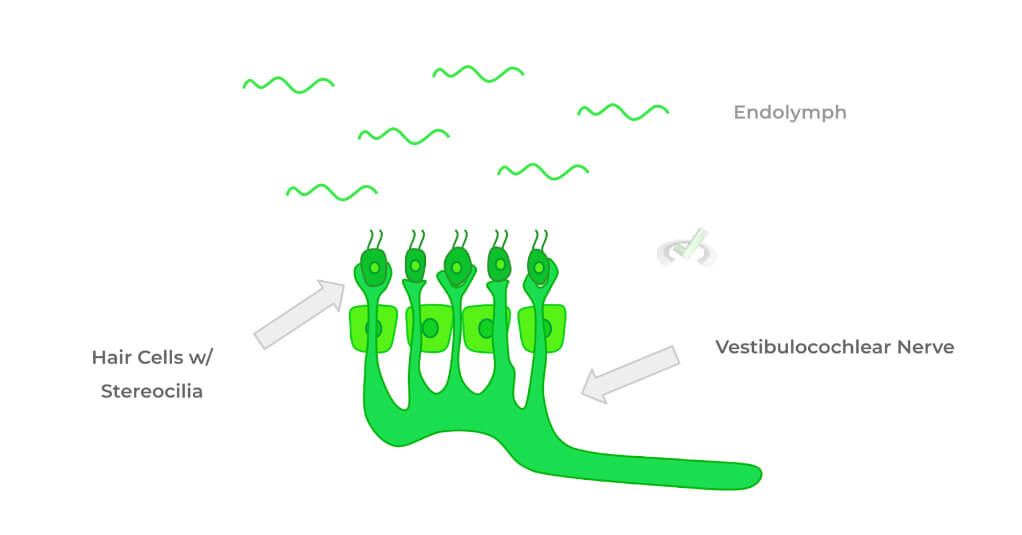
Additionally, there’s also a fluid housed within these organs called the endolymph — similar to the perilymph! Whenever the body moves, the endolymph fluid moves as well. As a result of the fluid movement, the cilia are also bent which stimulates an action potential eventually relayed towards the vestibulocochlear nerve.
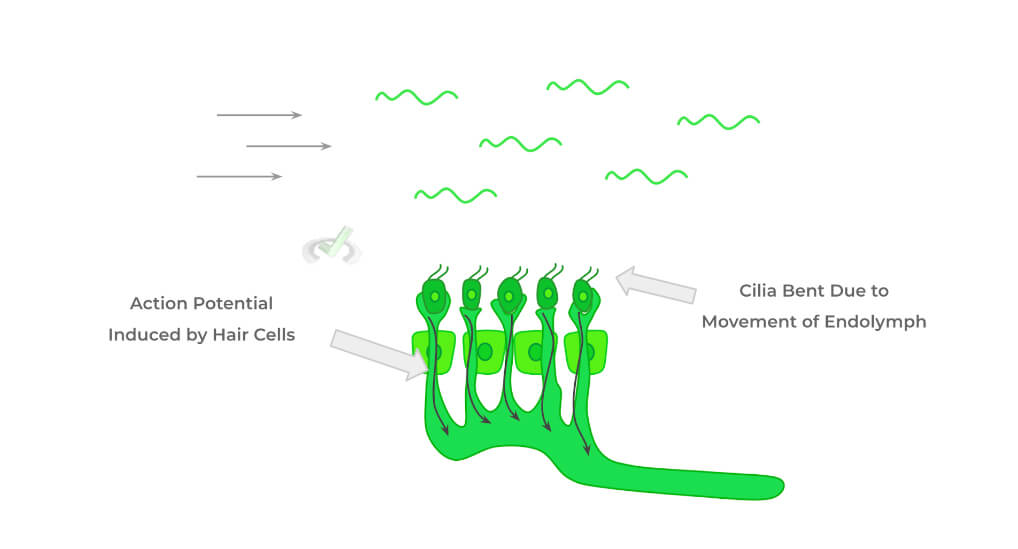
Luckily, the way we detect gustatory (taste) and olfactory (smell) stimuli is fairly similar to the normal way we think of receptors becoming activated. Within the tongue, and nasal cavity are numerous cells with receptors that extend from the cell body.
When a molecule binds to the appropriate receptors on gustatory and olfactory sensory cells (i.e. sugar binding to a “sweet taste” gustatory sensory receptor), it similarly triggers an action potential.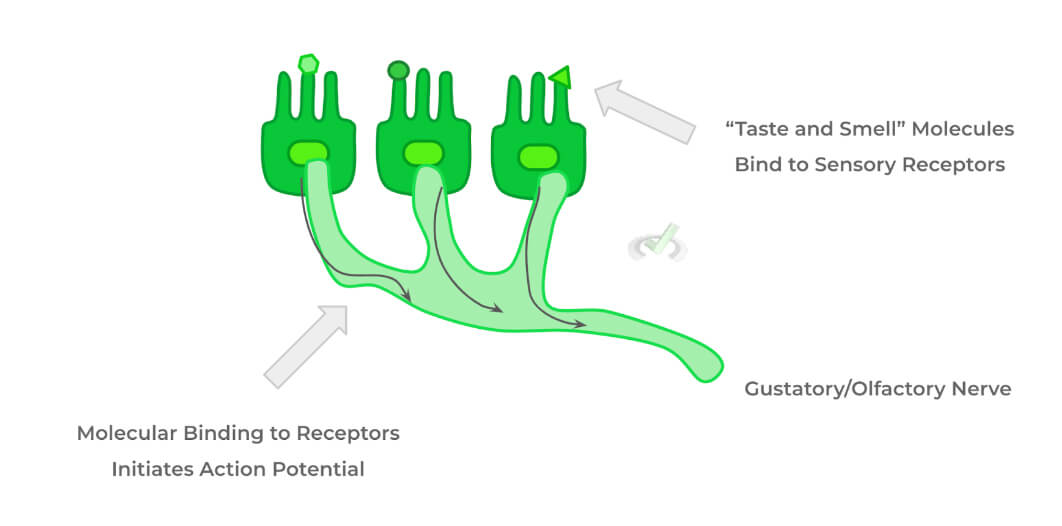
Full Study Notes : Other Types of Sensory Signal Transduction on the MCAT
For more in-depth content review on the types of signal transduction for different sensory stimuli, check out these detailed lesson notes created by top MCAT scorers.
5. Types of Processing in Perception
After the sensation of sensory stimuli, the signal is then transduced towards the appropriate brain region and is eventually processed in order to understand and assign meaning to the stimuli.
In general, there are 2 accepted ways/theories on how stimuli eventually come to be processed: 1) bottom-up processing and 2) top-down processing. As we’ll touch on, the primary difference between the 2 is cognition’s role in processing: does cognition influence perception or does perception influence cognition?
Bottom-up processing is data driven and specifically relies on the stimulus itself, as the stimulus alone results in our perception. From our perception of the stimuli, we can form a cognition: as such, bottom up processing supports the idea that our perception influences our cognition. Take a look at the example below:
Conversely, top-down processing is context driven: in other words, when we sense a stimulus, we utilize the existing context and past knowledge in order to aid in the formation of that perception. In this case, we say that our cognition influences our perception. Take a look at a similar example below!

Notice that our stimulus is now surrounded by the numbers 12 and 14. Now we have a little more context to add — being surrounded by the numbers, we can use our past cognition to expect that the stimulus is the missing number to the sequence.
Now, instead of being just a series of vertical and horizontal lines, the added context and past knowledge allow us to perceive the stimulus as the number 13. Indeed here, we see that cognition influenced how we perceived the stimulus.Full Study Notes : Types of Processing in Perception on the MCAT
For more in-depth content review on one (or rather a series) of visual schemes that best display top-down processing which is Gestalt principles, check out these detailed lesson notes created by top MCAT scorers.
Important Definitions and Key Terms
Below are some high yield definitions and key terms to refer to when reviewing concepts and ideas about sensation and perception!
Term | Definition |
|---|---|
Sensation | The biological process of detecting sensory stimuli via the stimulation of sensory receptors corresponding to specific stimuli |
Perception | The process where the brain integrates, analyzes, and associates meaning towards the stimuli |
Transduction | The process by which sensory stimuli is relayed towards the appropriate regions of the brain to be processed |
Lens | Transparent organ in the eye which is responsible for focus the light onto the retina |
Retina | Organ located towards the back of the eye that contains the photoreceptors which will sense and detect the incoming light stimuli |
Cone Photoreceptor | A type of photoreceptor that responsible for our color vision; Includes red, green, and blue wave cones photoreceptors |
Rod Photoreceptor | A type of photoreceptors that’s responsible for our achromatic color vision (i.e. black and white) |
Fovea | Segment of retina which has the highest density of cones |
Optic Nerve | One of the cranial nerves which is responsible for relaying the incoming visual stimuli to be processed by the visual cortex within the occipital lobe |
Cochlea | Inner ear organ responsible for the detecting and relaying of auditory stimuli |
Ossicles | Bones within the middle ear responsible for transmitting the incoming sound waves to the cochlea; Actually are the smallest bones of the body and consist of the malleus, incus, and stapes |
Organ of Corti | The main auditory sensory organ within the cochlea which consists of numerous hair cells |
Vestibulocochlear Nerve | One of the cranial nerves which is responsible for relaying vestibular and auditory information to the appropriate parts of the brain |
Vestibular Sense | Aids in maintaining our spatial awareness in 3D space, maintenance of balance, and sensing of linear acceleration |
Semicircular Canals | A collection of 3 canals which are positioned at right angles to one another; Senses our orientation and awareness in 3D space |
Otolith Organs | Includes the utricle and saccule; Also aids in our sensation of linear acceleration (and deceleration) |
Bottom-Up Processing | A type of processing which is data driven; in this processing, our perception influences our cognition |
Top-Down Processing | A type of processing which is context driven and also depends on past knowledge and information; in this case, our cognition influences our perception |
Additional FAQs - Sensation and Perception on the MCAT
What Are the 3 Steps of Sensory Processing – MCAT?
The sensory stimuli is eventually transduced, or relayed, to the appropriate region of the brain to finally be processed. Here, the signal is finally processed, whereby the brain integrates, analyzes, and associates meaning with the incoming sensory stimuli.



 To help you achieve your goal MCAT score, we take turns hosting these
To help you achieve your goal MCAT score, we take turns hosting these 
























